- WELCOME
- HOME
- ABOUT US
- CHAMPIONS
-
VERY IMPORTANT DOG
- Ch. South Fork's Jelly Bean
- Ch. South Fork's The Beat Goes On
- Ch. Yo Te Quiero Di Rio Galeria
- Ch. South Fork' Jazz It Up
- Ch. Tocai Di Rio Galeria
- Ch. South Fork's Contradiction
- Ch. South Fork's Music Man
- Ch. El Nino Di Rio Galeria
- Ch. Xsaraja Di Rio Galeria
- Ch. De Gozette Lotus
- Ch. Eldorado Di Rio Galeria
- Ch. Jaqueline Di Rio Galeria
- Ch. Dacarella's Hellf Angel
- SHOW RESULTS
- PUPPIES
- INFO CHIHUAHUA
- CONTACTS
- TOOLS
Dog Expertise
By Paolo Tartaro and Francesco di Paola Nuzzo
- Source: Magazine All About Chihuahua n° 4
| In this forth issue in order to continue our journey around the Chihuahua, we consider necessary the stop our description of the remaining regions (limbs, trunk and tail), that we will tackle after we have introduced some basic concepts essential to fully understand the breed. We will discuss topics such as harmony, bones, muscles, dog measurement, proportions and fundamental points of reference needed to the measurements in order to have a proper zootechnic verification of a dog breed. In previous issues of AAC these arguments have often been called into question, without specifying their exact meaning. One might ask why it is so important to know these concepts, without being a veterinarians. The usefulness of knowing these words and arguments is that we will talk about merits and faults with knowledge of the facts, referring to the breed standard, not entangled in sterile talks and avoiding the risk of being misunderstood and to create confusion. | |
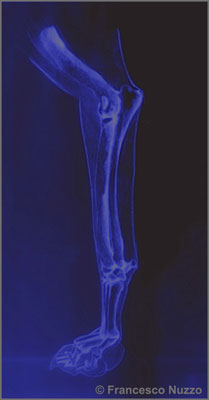 |
For example, we can not say that the trunk of a chihuahua is inscribed in the rectangle if we do not know how and where the measures of the trunk shall be taken. Or again: "harmony" this word has been used with great frequency in the previous issue, it is time to define the correct meaning of it in canine science and its importance for the Chihuahua breed. SKELETON AND JOINTS |
MUSCLES There are two types of muscle, striated and smooth. |
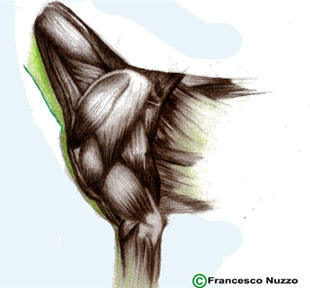 |
The concept of beauty in dog science |
|
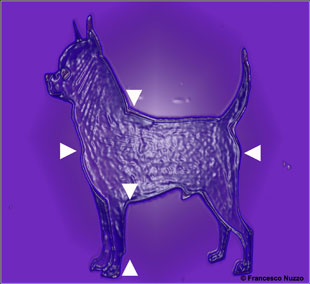 |
CYNOMETRC If we want to study on a breed to determine its key measures, we must make measurements on the largest number and on the better subjects of that breed available, and every measurement should be repeated several times in order to obtain an average as realistic as possible. Obviously we need to know where to take measurements, namely the so-called "landmarks", or the specific anatomical points, palpable and recognizable. Zoometric measurements are many, the cynometric adopted those of interest in dogs, we're going to explore the one needed in the following paragraph: • Height at the withers |
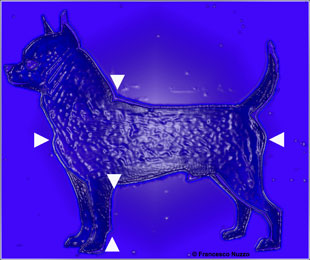 |
The height at the withers is measured from the withers (cynometric landmark) to the ground, tangentially to the elbow, the tool that we use to measure is the cynometer. This measure determines the height of the subject, then the size of the dog, this is the main measure of reference for all parts of the dog. The height of the elbow is taken with the cynometer from the tip of the elbow to the ground. Still, there are no specific cynometric studies on the Chihuahua breed that would allow a more precise classification of the morphology. We hope that very soon, thanks to the work undertaken by the CCC with the help of dr. and Judge Murante, this gap will be closed. PROPORTIONS The head is proportionate to the trunk. The latter is cylindrical, strong, compact it looks almost square with proper development of muscle and bone structure. In females a little extra length of the trunk is allowed (allowed does not mean that is desirable). The top line of the body is straight, the lower line, comeback gently in the ventral region, therefore avoiding the obesity look. |
|
The standard is of a body length only slightly longer than the height at the withers (... almost into the square), across the chihuahua will have to give the idea of great compactness, this feature is today increasingly sought after. The zootechnic checks has to give precise indications of selection to the breeders, who must be prepared to pursue a dog as close as possible to the standard. As we have repeatedly stated, they should not be led astray by personal taste, nor by fashion, avoiding the excesses, we are not looking for ring dogs, nor for heavy dogs with the typology of a small Asian dog, nor too light and with a lack of type, selection should always aim to get the real chihuahua: harmonious and balanced. |
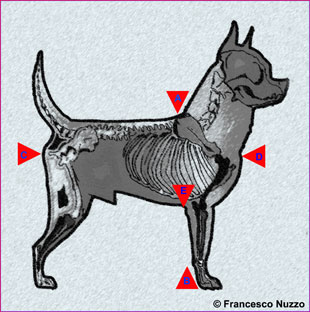 |
back to articles page
diriogaleria@chihuahua.it | musicvelvet@chihuahua.it
Words and images ©2011 Di Rio Galeria & Music Velvet Kennels - All rights reserved | Web site by TwentyfourCatsandDogs ©
